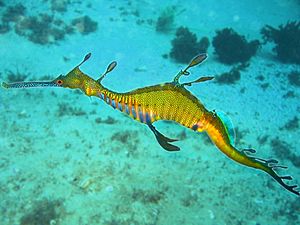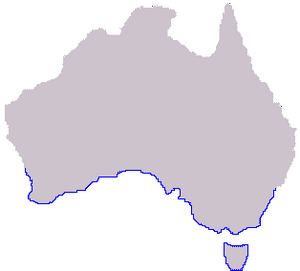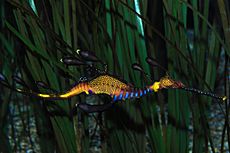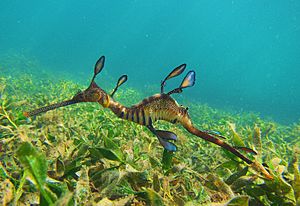Common seadragon facts for kids
Quick facts for kids Common seadragon |
|
|---|---|
 |
|
| A common seadragon in Cabbage Tree Bay, Sydney, Australia | |
| Conservation status | |
| Scientific classification | |
 |
|
| Where the common seadragon lives | |
| Synonyms | |
|
The common seadragon, also known as the weedy seadragon (Phyllopteryx taeniolatus), is a cool marine fish. It is a close relative of the seahorse!
These amazing creatures are usually reddish with yellow and purple spots. They have small, leaf-like parts on their bodies. These parts look just like swaying seaweed, helping them hide from predators. They also have short spines for protection. Male seadragons are thinner and darker than females. They have a long fin on their back and small fins near their neck. These fins help them balance as they swim. Common seadragons can grow up to 45 centimeters (about 18 inches) long.
The common seadragon is the official marine symbol of Victoria, an Australian state.
Contents
Where Do Seadragons Live?
The common seadragon lives only in Australian waters. You can find them in parts of the Eastern Indian Ocean, the Southern Ocean, and the South Western Pacific Ocean. They live along the coast from Port Stephens (New South Wales) to Geraldton, Western Australia. They are also found around Tasmania.
Seadragon Homes
Common seadragons live in coastal waters. They can be found as deep as 50 meters (about 164 feet). They like places with rocky reefs, beds of seaweed, and seagrass meadows. They also enjoy areas with structures covered in seaweed.
Seadragon Life and Habits
These fish move very slowly. They depend on their amazing camouflage to stay safe from animals that might want to eat them. They drift gently in the water, looking just like swaying seaweed. Unlike seahorses, they don't have a tail that can grab onto things to anchor themselves.
You might see common seadragons swimming alone or in pairs. They eat tiny crustaceans and other small ocean creatures called zooplankton. They suck their prey into their toothless mouths.
Just like seahorses, the male seadragon is the one who takes care of the eggs. The female lays about 120 eggs onto a special patch under the male's tail. The male carries these eggs for about a month. Then, the baby seadragons hatch! The young seadragons are independent right after they are born. They start eating very soon. Common seadragons take about 28 months to become adults. They can live for up to six years.
It is quite rare for seadragons to mate in aquariums. Researchers are still trying to understand what makes them want to reproduce. In the wild, not many young seadragons survive. But in aquariums, about 60% of them make it.
Some aquariums have successfully bred common seadragons. These include the Aquarium of the Pacific in California and the Tennessee Aquarium in Tennessee, USA. The Sea Life Melbourne Aquarium in Australia has also had success. In 2012, the Georgia Aquarium in Atlanta, USA, announced they had successfully bred them. The Monterey Bay Aquarium also successfully hatched baby seadragons in 2012.
What Threatens Seadragons?
The common seadragon is listed as "Least Concern" by the IUCN. This means they are not currently in great danger. People do want common seadragons for aquariums around the world. However, not many are caught from the wild, so this is not a big threat right now.
The biggest threats to common seadragons are losing their homes and pollution. Human activities are causing seagrass beds to disappear. Also, seaweed is being lost from rocky reefs near the shore. Seadragons don't move around much, so these changes put their future at risk. Luckily, they are not usually caught by accident in fishing nets. They are also not used in traditional Chinese medicine. These are problems for many of their relatives, like seahorses and pipefish.
Protecting Seadragons
It is against the law to catch or export these species in most Australian states where they live. A project called 'Dragon Search' helps protect them. It encourages divers to report any seadragon sightings. This project is supported by groups like the Marine Life Society of South Australia.
Aquariums are also working on breeding programs for the weedy seadragon. The Sea Life Melbourne Aquarium is leading this effort. It has been hard to breed them in captivity. But in 2015, researchers studied them in the wild. They tried to copy the conditions in the aquarium. Changing the light, water temperature, and water flow seemed to be the key!
In December 2015, eggs hatched at the Melbourne aquarium. By March 2016, 45 baby seadragons were still alive. This was a great success, with a 95 percent survival rate!
Seadragon Relatives
The common seadragon belongs to a group called Syngnathinae. This group includes all pipefish. Its closest relative is the ruby seadragon (Phyllopteryx dewysea). It is also related to the famous leafy seadragon (Phycodurus eques). The common seadragon was the only member of its group until the ruby seadragon was discovered in 2015.
Current Research
In 2006, the National Geographic magazine reported on marine biologist Greg Rouse. He is studying the DNA of the two seadragon species. He wants to see how they are different across their different homes.
- species name is missing
See also
 In Spanish: Dragón marino común para niños
In Spanish: Dragón marino común para niños





